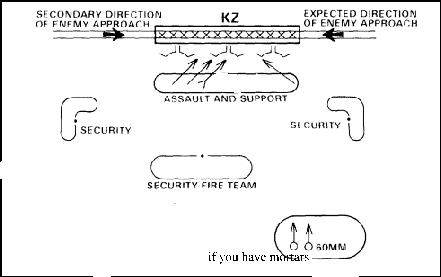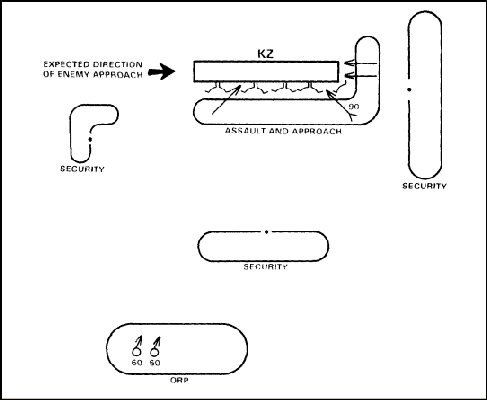![]()
Infantry Tactics
General ambush
| An ambush is a surprise attack, from a concealed position. It is used on a moving or temporarily halted enemy to destroy or capture him and his equipment. An ambush is a useful tactic because |
|
|
||
| Surprise. Surprise, more than any other single aspect, enhances the value of an ambush. Surprise increases the potential for inflicting damage on the enemy with less danger to the attacking force. | ||
| The mission Leaders/commanders must have contact with all members of their unit to alert them to the oncoming enemy. | ||
| As soon as the enemy is hit, he reacts. The ambush force has only a few seconds to destroy the enemy in the kill zone. He will quickly recover from the initial shock and leave the kill zone--either with a direct counterattack or withdrawal. | ||
| The leader always executes the ambush, except when a member of the ambush knows he has been discovered. He then has the authority to execute--with killing fire. | ||
| The flanks and rear of an ambush site are open to counterattack. players or units should be positioned to provide security . | ||
| when planning a ambush A simple, direct plan improves the chance of success. The ambush plan must be clear yet concise to offer the greatest likelihood of success. |
| players performing security, support, and assault tasks must be given clear, concise, and direct plans/orders. | ||||||||||||||
| Tasks to be performed by the ambushing players should be easy to understand | ||||||||||||||
| Always make a Contingency plan but Contingency plans should be simple. | ||||||||||||||
| Players in the ambush are organized to perform the following functions: assault, security, and support. The ambush forces should be task-organized according to the platoons, squads, etc | ||||||||||||||
| The elements ( players) assigned the assault mission: Conduct the main assault, halt an enemy's motorized column or any moving target, Kill the Enemy ,Destroy vehicles and supplies. | ||||||||||||||
| The elements ( players) assigned the mission of security: Secure both side flanks & rear flanks, Provide early warning of the approaching enemy and or additional enemy units, Seal off the kill zone to prevent the enemy from escaping or reinforcing, assist in executing the ambush, cover withdrawal of main ambush force. | ||||||||||||||
| The units (players) assigned a support mission provide
fires that may include employment of machine guns , mortar, and/or
anti
tanks weapons.
|
||||||||||||||
WHEN CHOOSING A SITE: |
||||||||||||||
| When choosing an ambush site, all sources of information must be used to enhance surprise, exploit the enemy's weak points, and take advantage of the terrain. Emphasis is placed on: | ||||||||||||||
|
||||||||||||||
|
![]()
Two main set up for a ambush:
Liner Ambush

L shaped ambush

| In the L-shaped ambush, weapons must be sited to avoid direct into friendly forces |
|
Two final things that are needed to considered 1) Swift action. Speed in the execution of the ambush and the withdrawal should prevent enemy reaction forces from engaging the ambush force. Speed is often a shield against casualties and failure. |
| make sure u have a Objective rally point.( A point were every player meets AFTER) The ORP is located far enough from the ambush site so that it will not be overrun if the enemy manages to attack the ambush unit's). Routes of withdrawal to the ORP are practiced or scouted (when possible by each player), Withdrawal routes should provide cover and concealment for the unit and hinder enemy pursuit. Withdrawal routes are a main consideration in the selection of the ambush site. They may be the key to survival after execution of the ambush. On signal, the ambush force quickly (but quietly) withdraws to the ORP. If pursued, the withdrawal may be by bounds, or even a hasty ambushes used to delay pursuing forces. |
|
|
To to counter a Ambush the following should be done
| ) When all elements( players) of a friendly force are not trapped within the ambush, the elements that are free to maneuver should initiate an immediate flank or rear assault against the ambush force. A flank assault permits better coordination with personnel in the ambush. Supporting fires are provided by those weapons that cannot be hand carried and fired in the assault such at machine guns and or anti tanks weapons . |
| On a near ambush( close to the friendly units). Elements (players) caught in the kill zone return fire at once and move out of the kill zone. Elements not in the kill zone help by maneuvering and conducting a flanking attack. The unit assaults the ambush position. |
| On a FAR ambush. Those elements (players) not in the kill zone set up an overmatch position and lay down a base of fire for the elements in contact. The elements in contact move out of the kill zone and prepare to assault the enemy, using individual movement techniques and fire and movement. |
